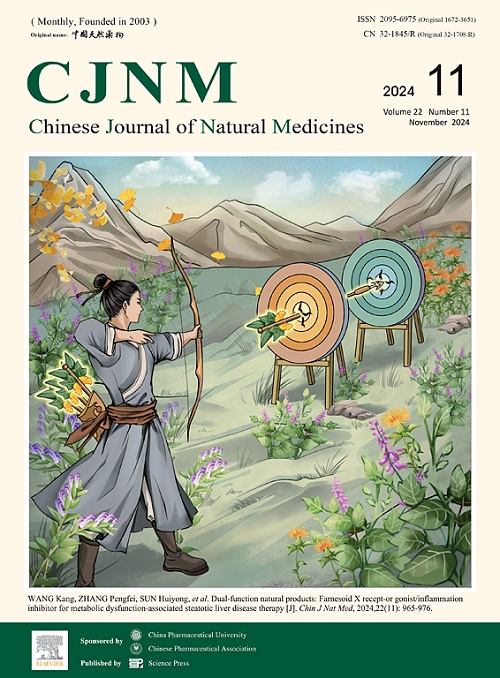基于转录组学的疾病网络揭示了黄连总生物碱和人参总皂苷对2型糖尿病的协同治疗作用
IF 4.9
2区 医学
Q1 INTEGRATIVE & COMPLEMENTARY MEDICINE
引用次数: 0
摘要
黄连(Coptis chinensis)和人参c.a.m y。是传统的草药,有几千年的使用记录和广泛的治疗应用,包括抗糖尿病的特性。然而,黄连总生物碱和人参总皂苷对2型糖尿病(T2DM)的协同作用及其机制尚不清楚。研究表明,黄连总生物碱与人参总皂苷的最佳配比为4∶1,对改善小鼠原代肝细胞胰岛素抵抗和糖异生的效果最佳。该组合在改善糖耐量、降低空腹血糖(FBG)、附睾白色脂肪组织(eWAT)的重量比以及瘦素受体缺陷(db/db)小鼠胰岛素抵抗(HOMA-IR)的稳态模型评估方面显示出显著的协同作用。随后,基于RNA测序(RNA-seq)实验和公共数据库,通过整合疾病相关蛋白和蛋白-蛋白相互作用(PPIs)的转录特性,构建了T2DM肝脏特异性网络。以4∶1的比例联合治疗组的网络恢复指数(NRI)评分高于单独治疗组。本研究通过db/db小鼠的western blot实验证实,肝脏活化的腺苷5′-单磷酸活化蛋白激酶(AMPK)/乙酰辅酶a羧化酶(ACC)信号通路在T2DM的协同治疗中发挥了至关重要的作用。结果表明,黄连总生物碱与人参总皂苷4∶1联合用药可显著改善db/db小鼠的胰岛素抵抗和糖脂代谢紊乱,效果优于单独用药。协同机制与AMPK/ACC信号通路活性增强有关。本文章由计算机程序翻译,如有差异,请以英文原文为准。
The transcriptomic-based disease network reveals synergistic therapeutic effect of total alkaloids from Coptis chinensis and total ginsenosides from Panax ginseng on type 2 diabetes mellitus
Coptis chinensis Franch. and Panax ginseng C. A. Mey. are traditional herbal medicines with millennia of documented use and broad therapeutic applications, including anti-diabetic properties. However, the synergistic effect of total alkaloids from Coptis chinensis and total ginsenosides from Panax ginseng on type 2 diabetes mellitus (T2DM) and its underlying mechanism remain unclear. The research demonstrated that the optimal ratio of total alkaloids from Coptis chinensis and total ginsenosides from Panax ginseng was 4∶1, exhibiting maximal efficacy in improving insulin resistance and gluconeogenesis in primary mouse hepatocytes. This combination demonstrated significant synergistic effects in improving glucose tolerance, reducing fasting blood glucose (FBG), the weight ratio of epididymal white adipose tissue (eWAT), and the homeostasis model assessment of insulin resistance (HOMA-IR) in leptin receptor-deficient (db/db) mice. Subsequently, a T2DM liver-specific network was constructed based on RNA sequencing (RNA-seq) experiments and public databases by integrating transcriptional properties of disease-associated proteins and protein-protein interactions (PPIs). The network recovery index (NRI) score of the combined treatment group with a 4∶1 ratio exceeded that of groups treated with individual components. The research identified that activated adenosine 5’-monophosphate-activated protein kinase (AMPK)/acetyl-CoA carboxylase (ACC) signaling in the liver played a crucial role in the synergistic treatment of T2DM, as verified by western blot experiment in db/db mice. These findings demonstrate that the 4∶1 combination of total alkaloids from Coptis chinensis and total ginsenosides from Panax ginseng significantly improves insulin resistance and glucose and lipid metabolism disorders in db/db mice, surpassing the efficacy of individual treatments. The synergistic mechanism correlates with enhanced AMPK/ACC signaling pathway activity.
求助全文
通过发布文献求助,成功后即可免费获取论文全文。
去求助
来源期刊

Chinese Journal of Natural Medicines
INTEGRATIVE & COMPLEMENTARY MEDICINE-PHARMACOLOGY & PHARMACY
CiteScore
7.50
自引率
4.30%
发文量
2235
期刊介绍:
The Chinese Journal of Natural Medicines (CJNM), founded and sponsored in May 2003 by China Pharmaceutical University and the Chinese Pharmaceutical Association, is devoted to communication among pharmaceutical and medical scientists interested in the advancement of Traditional Chinese Medicines (TCM). CJNM publishes articles relating to a broad spectrum of bioactive natural products, leading compounds and medicines derived from Traditional Chinese Medicines (TCM).
Topics covered by the journal are: Resources of Traditional Chinese Medicines; Interaction and complexity of prescription; Natural Products Chemistry (including structure modification, semi-and total synthesis, bio-transformation); Pharmacology of natural products and prescription (including pharmacokinetics and toxicology); Pharmaceutics and Analytical Methods of natural products.
 求助内容:
求助内容: 应助结果提醒方式:
应助结果提醒方式:


